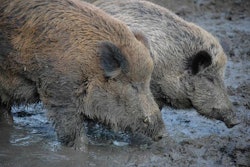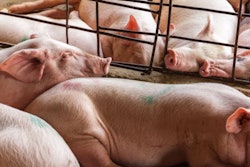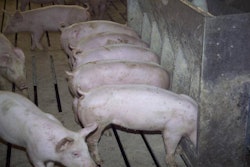
Representatives from federal and provincial governments meet weekly with pig industry representatives to discuss African swine fever concerns
Close collaboration between governmental entities and the pig industry in Canada is helping the North American country be better able to keep African swine fever (ASF) out of Canada, as well as minimize the impact should the disease emerge there.
Egan Brockhoff, veterinary counselor for the Canadian Pork Council, told attendees of Kansas State University (KSU) Swine Day, held November 21 in Manhattan, Kansas, about what is being done in terms of ASF prevention and preparedness, as well as what can be done regarding ASF response and recovery.
 Egan Brockhoff, veterinary counselor for the Canadian Pork Council (Roy Graber)
Egan Brockhoff, veterinary counselor for the Canadian Pork Council (Roy Graber)For the Canadian pork industry, which is largely export-driven, an ASF outbreak and subsequent trade barriers would be catastrophic, Brockhoff said.
“We export 70% of our pork production in Canada. If our borders close, we have a massive crisis tomorrow. We don’t have finisher spaces. We don’t have anywhere for those pigs to go. We don’t have the capacity to kill them. We don’t have the capacity to deal with that crisis,” he said.
But the disastrous potential of an ASF outbreak in Canada is not lost on the government, at the federal and provincial levels.
During summer 2019, Canada activated its National Emergency Operation Center, which is an industry-government initiative.
“What really excites me about this is industry is at the table,” Brockhoff said. “Industry drove this conversation and industry came to the table. It’s not solely federal or provincial government. All three of us are working together collaboratively to make sure this disease doesn’t impact us or doesn’t come to the country.”
Through the National Emergency Operation Center, representatives from all entities meet weekly and discuss the ASF front and what more needs to be done. Among the key federal agencies involved are the Canadian Food Inspection Agency (CFIA) and the Canada Border Services Agency (CBSA).
“These national working groups have been going strong, and have helped us peel back layers of the onion to see what we are ready for and what we are not ready for,” he said.
Care with feed ingredient importation
Lessons from a 2014 outbreak of porcine epidemic diarrhea virus (PEDv) in Canada have been applied in the prevention of ASF spreading into Canada, particularly when it comes to importing feed ingredients.
PEDv had already been in the United States for nine months before it entered Canada – through contaminated feed ingredients. Twenty barns were quickly infected, Brockhoff said, which started the conversation about feed ingredients being a biosecurity risk. KSU researchers were key to that conversation, he acknowledged.
When news of ASF in Asia and Europe began to surface, a risk analysis was done and presented to the government.
Because Canada imported feed ingredients, the federal government adopted policies involving the importation of such materials. Previously, only the import of animals and animal byproducts were encompassed in the Health of Animals Act, so regulations regarding plant-based feed ingredients were not covered.
That changed in March, when Canadian Agriculture Minister Marie-Claude Bibeau declared secondary control zones, which included the country’s six major shipping ports. Bibeau’s order also called for certain “designated things” (DT) such as unprocessed grains, oilseeds and associated meals destined for livestock feeds, to require a permit to be taken into a secondary control zone. The permit holder must keep records to identify the DT.
Bibeau can reject the permit if the DT entering the secondary zone is likely to result in an ASF introduction.
Airlines and airports
One high area of concern for the spread of ASF is air passengers traveling to Canada who bring food on flights with them.
In March, Bibeau announced the allocation of CA$31 million (US$23.3 million) to expand its canine teams at Canadian airports.
Brockhoff said since that time, canine teams have been focusing on “high-risk air transportation,” which he defined as passengers who come from ASF-positive countries.
CBSA has placed signage in prominent places explaining the ASF alert, informing travelers they must declare meat products for travel, and explaining what the fines for violations are. These signs are in multiple languages, as he showed an example of one sign at the airport in Vancouver, British Columbia.
The airlines have also gotten involved. Brockhoff explained that many airlines hosting international travelers begin telling passengers about 20 minutes prior to landing of ASF risks and the fines for violations.
Passengers are also required to leave their “international waste” on the airplanes, so it can be “destroyed in a safe, biosecure way,” Brockhoff said.
Small herds and wild hogs
Canada has about 7,000 small-scale pork producers, which are not members of the Canadian Pork Council or other provincial associations, nor do they send their pigs to federally or provincially inspected plants. Those producers may have the ASF knowledge the larger producers do, so two of the provinces have started funding projects to build resources for them, such as manuals that explain good ASF precautionary measures.
There is also a wild pig herd in Canada. Because wild pigs have been carriers of ASF in other countries, this is an area of concern. Environmental and wildlife organizations are getting involved and funding programs to address ASF risks, Brockhoff said.
View our continuing coverage of the African swine fever outbreak.



















